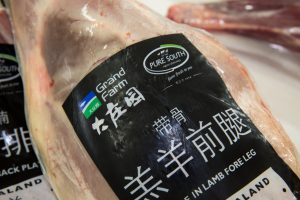Green shoots emerging after tough season
Farm gate returns for lamb and mutton have passed the bottom of the latest downward cycle, but farmers can expect only small increases for the 2024-25 season ahead. Words Tony Leggett.

Meat companies, bank economists and market commentators are reporting signs of green shoots emerging from global markets for sheep meat and say the longer-term outlook is positive.
In spite of another significant decrease projected in the size of the 2024-25 export lamb kill, farmers should not bank on much more than $6.20-6.40/kg for prime lamb in the crunch kill months of January and February next year. Beef + Lamb New Zealand (B+LNZ) is forecasting the lamb crop to be down by another 970,000 head this spring, and expects 7% drops in the export kill for both lamb and mutton for the year to September 2025.
It is forecasting the lamb price to average $130 per head, up just 1.1% from last season but still 8.2% below the five-year average. Mutton prices are expected to remain steady at $60/head, still down a whopping 46% on the five-year average.
In the season just ended on 30 September 2024, the average lamb price is likely to finish around 14% below last season’s average, which itself was down 15% on the season before in real (inflation adjusted) terms, this season’s average lamb price will be around 21% down on its 10-year average, creating extremely challenging economics.
For beef, this season’s average price is shaping up to be marginally higher than last season’s average. However, in real (inflation adjusted) terms, this season’s average beef price will be around
9% below its 10-year average.
Looking to next season, early drafts through October and November should still achieve a per kilogram price starting with a $7 before demand for space ramps up through the normal peak kill period from January to March.
Market analysts at AgriHQ forecasted a $6.40/kg prime lamb price for next January in their August outlook.
Two key drivers of red meat price weakness over the past year have been subdued demand from China and significantly higher supply from Australia.
The share of NZ beef and sheepmeat exports bound for China has fallen significantly over the past two years. In the year to June 2024, China’s share of NZ sheep meat exports has fallen to 29% from 40% (which was down from a recent peak of over 50% in 2021).
The positives are that in early September, there was a significant decrease in lamb processing numbers in Australia. Lamb exports from Australia have soared in the past two years on the back of good rainfall, and more ewes mated to meat breed rams, putting greater pressure on global lamb and mutton markets, particularly China and the United States.
B+LNZ says if the downward trend in export volume from Australia continues it could result in global lamb prices lifting higher than it is currently forecasting.
‘What could NZ learn from Australia? How could we work with them? These are questions I think we need to ask ourselves.’ – Jen Corkran, Rabobank
Rabobank red meat economist, Jen Corkran also noted the drop in Australia’s lamb export volume in the annual lamb outlook report released in early September. She says farmers can be assured global sheep meat prices are past the bottom of the cycle. “I’m reasonably confident we won’t see less than $6/kg for some time,” she says.
Her report confirms a distinct market shift away from relying so heavily on China, and a return to NZ’s historic and stable markets for lamb like the United Kingdom, European Union countries, United States and the Middle East.
She says exporters are mindful of China’s push for self sufficiency in food production. Its domestic flock is increasing and although it is a volume market for lower value lamb cuts and mutton, that results in lower average market prices compared with the higher value markets elsewhere.
“We have a great history of supplying lamb to the UK and Europe, but since 2019, China has dominated the export markets for our product, taking nearly half our lamb and 78% of all our mutton exports at its peak,” she says.
Corkran says there is a great opportunity to focus back on the UK and EU and send more to those markets which have dwindled in recent years in spite of our significant quota-free allowance and less supply pressure from Australian exporters.
‘In my opinion the long-term outlook for sheep meat for NZ is positive. I’m more optimistic than most, and while we won’t hit the five-year average price,
I feel the bottom of the cycle has been reached this past season.’ – Jen Corkran, Rabobank
“The other big green shoot is that the UK sheep flock is in huge decline, which is positive for NZ exports. It’s because subsidies are coming off and there’s land use change driven by environmental concerns.”
Corkran doesn’t see the same sized opportunity to build volume going to the United States because the heavier carcase weight Australian lamb is preferred by many importers for the food service trade.
She sees an opportunity for the NZ meat industry to consider reviewing its structure and its distribution models given the declining supply of lamb and mutton. “The current downward cycle in pricing highlights a need for change, for more consistency in earning along the sheep supply chain.”
Everyone involved in the value chain will be at the mercy of future boom and bust cycles if the sector doesn’t embrace the need for changes that can deliver more consistency. “It’s not that we’re doing anything wrong necessarily, it is just timely to ask if we’ve got the best sheepmeat strategy for the markets we supply.
China’s animal protein consumer market has entered a new stage where demand is becoming more sophisticated and a product’s value proposition must go beyond the product itself to include service and even a valued experience for consumers. – RaboResearch report, September 2024
“I still think the longer-term outlook for sheep meat is positive, but we have to remember it is still a very niche product in a global sense, compared to beef which is consumed widely and in many different forms.”
Corkran also believes exploring ways to collaborate more closely with Australia could be timely. “What could NZ learn from Australia, and how could we work with them are questions I think we need to ask ourselves,” she says.
NZ and Australia export close to 70% of the globally traded lamb, providing a combined volume strength that could be leveraged to provide more consistent, higher prices.
Australia’s flock size is more than three times bigger than NZ’s and the average carcase weight of lamb is 24kg versus just under 19kg for NZ lamb. Australia also has a more diverse end-game for lamb, consuming about 37% domestically and shipping only 14% to China compared with 48% for NZ for the period from 2019-2023.
What is more difficult to predict is how meat companies will operate during the coming season particularly when faced with fewer lambs available for export. That will depend on climate (supply curve), currency and export markets (demand).
A red-hot store market out of kilter with export values is not an environment that meat companies or farmers will enjoy for long. Delivering inflated prime stock prices as meat companies hunt for killable stock to keep plants ticking over is not a recipe for long term viability.
With the tightening of numbers, some power has shifted back to livestock breeders as the historic relativity between store and prime stock values defies logic and squeezes margins for finishers.
Any breeders who are topped up with good quality stock will find themselves “in the box seat” according to one farm consultant. At the same time, higher store prices mean a bigger capital outlay and more debt to fund it so risk levels increase.
 Chinese happier with higher value protein
Chinese happier with higher value protein
A just-released report on the animal protein market in China suggests it is rapidly becoming a higher value market.
Chinese consumers are becoming more concerned about their diet and overall health as average wealth increases among China’s bulging middle class and the overall population ages as the birth rate dips lower. The report from RaboResearch says the animal protein market in China has been oversupplied for more than a year, resulting in sluggish prices and a supply chain struggling to cope. “The era of supplying homogenous products to meet basic needs is over,” the report says.
“China’s animal protein consumer market has entered a new stage where demand is becoming more sophisticated and a product’s value proposition must go beyond the product itself to include
service and even a valued experience for consumers.”
Four consumption trends are emerging in China. Consumers are seeking value for money, more emphasis on the experience, spending on nutrition and health is rising, and there is a continuous evolution of distribution channels.
The report notes significant changes to China’s economy in recent years. Growth has slowed but the wealth of middle-class Chinese consumers has increased substantially.
Consumers are still seeking value-for-money products, but there is also a willingness to pay for high-value products that offer fulfillment and allow them to experience new things. Health issues such as obesity are also driving changes, forcing some consumers to seek a more balanced diet and focus on healthy eating.
In recent years, China’s population demographic has shifted towards an aged society with a smaller household size. The population is forecast to drop from the current 1.4 billion people to 1.3 billion by 2050 and experts estimate the population aged 65 and above could exceed 20% of the total.
The report says the shift in the population to older average age will have a big impact on consumption of animal protein, shifting it to a greater focus on nutrition and dietary health. This is likely to alter the mix of protein consumed by Chinese people, away from pork which is perceived to be more difficult to digest than poultry, and towards beef and seafood which are perceived as more nutritious.
Changes are also appearing in the way the aging Chinese consumers buy their food. Importantly, this age group has already embraced e-commerce with its new retailing and food delivery systems, and convenience foods. Average household size is dropping as fewer young people get married and have children. The down-sizing of Chinese households is expected to have a big impact on consumption habits. “While the traditional three-person households tend to cook for kids and focus on food safety, the smaller one-or-two-person household proactively looks for time and cost efficiency.
“As a result, online shopping, convenience stores, dining out, food delivery and convenience food has developed fast in recent years to cater to this rising demand for convenience.”
Beef + Lamb New Zealand New Season Outlook 2024/25
Drought and land use changes are behind a further reduction in New Zealand’s sheep numbers for the year to 30 June 2024.
Beef + Lamb New Zealand’s (B+LNZ) annual livestock survey was released in early August and confirmed a 10% drop in sheep and beef numbers over the past three years. Sheep numbers for the year to 30 June 2024 were 4.3% down on the previous year to 23.31 million head.
Breeding ewe numbers only dropped 2.9% but trading sheep numbers were down a whopping 7.9%, reflecting the challenges delivered by ongoing drought in several regions of the country.
The big take-home message in the Livestock Survey report was the 4.8% decrease forecast for the 2024 spring lamb crop. That’s almost 1 million fewer lambs available for replacements and export markets.
B+LNZis not expecting livestock numbers to recover to pre-drought levels and also noted a probable shift into more cattle for the sector, reflecting the sharply higher store prices and lower workload.
In early September B+LNZ released a slightly optimistic New Season Outlook report for 2024-25, noting a continuation of difficult times for the meat sector but also suggesting there are signs of ‘green shoots’ on the horizon. The report forecasted that farm profitability for 2024-25 will remain under pressure, with Farm Profit Before Tax expected to decrease by 7.4% to an average of $45,200 per farm.
Although revenue is forecast to increase slightly, up 1.1%, this is offset by a projected 1.8% rise in farm expenditure.




